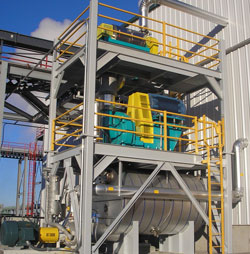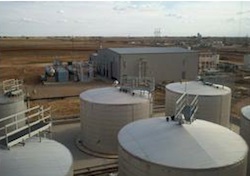 ICM, Inc. has completed full-scale commercial installations of its new Selective Milling Technology™ (SMT) at four ethanol plants. The plants that have installed the technology are LifeLine Foods LLC, Kansas Ethanol LLC, Green Plains Shenandoah, LLC and Lincolnland Agri-Energy LLC.
ICM, Inc. has completed full-scale commercial installations of its new Selective Milling Technology™ (SMT) at four ethanol plants. The plants that have installed the technology are LifeLine Foods LLC, Kansas Ethanol LLC, Green Plains Shenandoah, LLC and Lincolnland Agri-Energy LLC.
Formerly known as Fine Grind Technology, ICM is unveiling its new product name of Selective Milling Technology™, because it more accurately describes what the technology is doing. According to ICM Technical Director for Product Development Dr. Scott Kohl, Ph.D., “The process of using energy to free more starch for enzyme conversion to sugar can involve breaking larger starch particles into smaller ones; or breaking/rolling starch away from fiber, protein, or fats. Our SMT™ allows plants to maximize this added energy by targeting the particles that can benefit from it most.”
 ICM has worked collaboratively with Fluid-Quip, Inc. to develop the technology and deliver it to the marketplace; Fluid-Quip is ICM’s equipment provider for the SMT™ systems. In addition, ICM has obtained the rights to license the SMT™ technology to commercial plants from Lee Tech, LLC.
ICM has worked collaboratively with Fluid-Quip, Inc. to develop the technology and deliver it to the marketplace; Fluid-Quip is ICM’s equipment provider for the SMT™ systems. In addition, ICM has obtained the rights to license the SMT™ technology to commercial plants from Lee Tech, LLC.
Customer provided data from operations of ICM’s SMT™ illustrate the various benefits that are derived from this revolutionary platform technology, including: increased ethanol yields of 1.5% – 3.0%, increased oil recovery yields of 11% – 18%, and ultimately, increased revenues. Reflecting on the positive SMT™ data analysis to date, Kansas Ethanol Operations Manager Thane Combs said, “After running the SMT™, we are pleased with how it boosted our ethanol yield, lowered residual WDGS starch and most importantly, improved our bottom line.”
ICM President Chris Mitchell said, “We continue to focus our efforts on developing solutions that deliver value-added product streams to the renewable energy industry. We believe our competitive advantage comes from providing our customers with products that deliver immediate returns for them coupled with our expanding platform technologies that we’re excited to launch.”
A full-scale SMT™ disc mill, paddle screen and time-lapse photos/video of the technology being installed will be on display at ICM’s booth (#715) at the Fuel Ethanol Workshop (FEW), June 4-7 in Minneapolis, MN. In addition, SMT
ICM also announced today that Southwest Iowa Renewable Energy (SIRE) has purchased the company’s Advanced Process Controls (APC) system to be installed and commissioned at the 110 MGY plant in Council Bluffs. ICM’s APC package is an advanced hardware and software integrated solution designed to maximize plant efficiency by eliminating variability in operational parameters in critical areas such as slurry solids, water balance, beer column/evaporators, molecular sieves, dryers, fermentation, and stillage/centrifuges.
 New Mexico is set for biodiesel with the soon to open B100 biodiesel terminal in July. Once online, this will be the state’s largest biodiesel terminal, which is owned and operated by the Renewable Energy Group (REG), the country’s largest biodiesel producer. Product will be available from the Clovis, New Mexico facility in July.
New Mexico is set for biodiesel with the soon to open B100 biodiesel terminal in July. Once online, this will be the state’s largest biodiesel terminal, which is owned and operated by the Renewable Energy Group (REG), the country’s largest biodiesel producer. Product will be available from the Clovis, New Mexico facility in July.








 ICM has worked collaboratively with Fluid-Quip, Inc. to develop the technology and deliver it to the marketplace; Fluid-Quip is ICM’s equipment provider for the SMT™ systems. In addition, ICM has obtained the rights to license the SMT™ technology to commercial plants from Lee Tech, LLC.
ICM has worked collaboratively with Fluid-Quip, Inc. to develop the technology and deliver it to the marketplace; Fluid-Quip is ICM’s equipment provider for the SMT™ systems. In addition, ICM has obtained the rights to license the SMT™ technology to commercial plants from Lee Tech, LLC. “We are extremely disappointed in that vote because I think it fails to recognize and appreciate the enormous potential of this industry to revitalize the rural economy,” said Vilsack during a conference call today when asked specifically about a vote last week by the Senate Armed Services Committee that would prohibit the military from spending money on alternative fuels. “I certainly hope that as this process continues folks will understand the negative impact such a vote has on rural America and will decide that the Navy, USDA and Department of Energy are on the right track to produce these new fuels.” The House Armed Services committee is considering a similar amendment to the defense spending bill.
“We are extremely disappointed in that vote because I think it fails to recognize and appreciate the enormous potential of this industry to revitalize the rural economy,” said Vilsack during a conference call today when asked specifically about a vote last week by the Senate Armed Services Committee that would prohibit the military from spending money on alternative fuels. “I certainly hope that as this process continues folks will understand the negative impact such a vote has on rural America and will decide that the Navy, USDA and Department of Energy are on the right track to produce these new fuels.” The House Armed Services committee is considering a similar amendment to the defense spending bill. 
